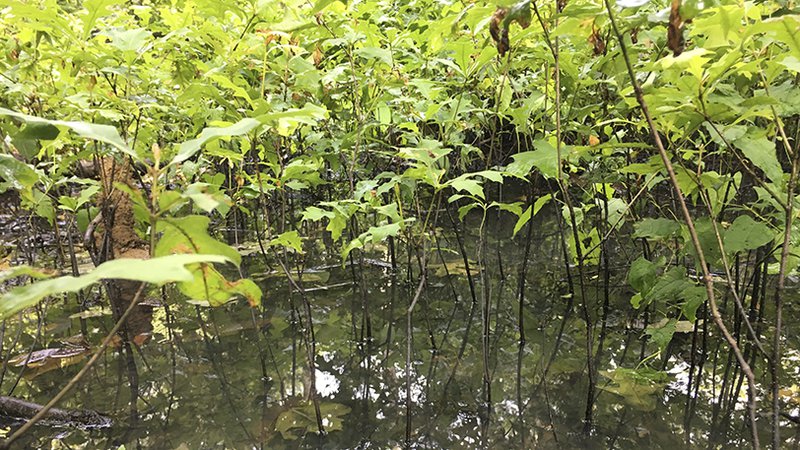Forest management plants seeds for future hunting opportunity at Dagmar WMA
ON 07-29-2019

July 29, 2019
Randy Zellers
Assistant Chief of Communications
BRINKLEY — Wildlife habitat at Sheffield Nelson Dagmar Wildlife Management Area in Monroe County has seen a huge boost for the future, thanks to proactive work to create the next generation of forest on a small portion of the area managed for waterfowl. Habitat surveys conducted this spring show excellent results from the recent removal of select trees on Mud Slough Greentree Reservoir, promoting food for ducks, deer and a variety of other wildlife species for many generations to come.
In 2016, after decades of stress caused by flooding during the growing season and early fall, wildlife habitat biologists with the Arkansas Game and Fish Commission conducted a 217-acre thinning to stimulate wildlife food and increase the quality of the habitat in the area. Habitat surveys in 2018 revealed thousands of oak seedlings sprouting in the areas where the older less desirable and stressed trees had been removed.
Biologists then made the hard decision to leave the area open instead of intentionally flooding it last winter during waterfowl season. Although the area did flood occasionally during the season, the draining of the area after every flood event and removal of stagnant water paid off.
“In 2018, we saw an average of 600 Nuttall and willow oak seedlings per acre,” said Rob Willey, habitat coordinator for the AGFC. “After keeping the water control structures open and letting water flow through the system all winter long, we’ve seen 79 percent survival of those seedlings and even more sprouting. We are now averaging 800 seedlings per acre of beneficial oaks.”
Drawing Ducks to Dagmar
Dagmar WMA has three greentree reservoirs, totalling 1,482 acres of flooded waterfowl habitat when water from Robe Bayou and Bayou DeView is held back in winter. The largest of these GTRs is Mud Slough, which encompasses 1,178 acres of hardwood forest. Nearly all of Dagmar was heavily logged before the Arkansas Game and Fish Commission took ownership of the land in 1952, but there are cypress-tupelo brakes with some trees that proved too difficult to harvest and have since continued to grow in the wettest areas. The heavy cutting resulted in an open area where red oak species, such as willow oak and Nuttall oak thrived.
As greentree reservoirs were developed on the area, mallards on their annual migration took notice of this island of flooded timber in the surrounding sea of agricultural land. They came to to feed on invertebrates in the leaf litter and the small, yet abundant acorns found in the flooded understory. It did not take long for hunters to learn that when water was present, Dagmar had ducks.
Gradual Change
Shifts in water use and hydrology across the landscape of Arkansas have placed more water on the trees in these seasonal reservoirs during the growing season. Abundant duck populations also have accommodated 60-day seasons for the last two decades, resulting in demand for huntable water well before the trees are dormant. According to “Conserving Arkansas’s Flooded Timber Legacy,” a special AGFC publication mailed to every duck stamp holder in Arkansas in 2017, red oak species become stressed when their roots and trunks are repeatedly covered with water during the growing season. Now well over 60 years old, many of the trees in greentree reservoirs developed decades ago need help.
The willow oaks and Nuttall oaks that once provided food for ducks have been slowly replaced by more water-tolerant species that do not produce the same quality of food. Those preferred oaks that do remain also show signs of stress, which concerns area managers about the future of the area’s wildlife habitat and hunting opportunity.
Let the Sun Shine in
To the hunter who loves to sit under an oak tree during deer or duck season, cutting trees with the notion of benefitting wildlife can be hard to understand. This can be especially true when some of those trees are still producing some acorns. But all oaks are not created equal, and wildlife need more than a few months worth of acorns. They have to eat all year, and they need a variety of foods that also includes grasses, seeds and fruits. Waterfowl need a wide range of foods in their diets as well. They flock to agricultural crops like kids to a candy store, but they also need the cover of flooded woods and thicker habitat. They also need nutrients and proteins found in invertebrates and other food sources of the mixed habitat types to complete their migrations and be in good condition to breed, nest and hatch the next generation of birds.
A closed forest canopy smothers any attempt of those annual grasses, smartweeds and plants rich in seeds. Young red oak also cannot sprout and grow to replace dying trees without proper sunlight. Much like the current forest, which is the product of timber removal decades ago, any future forest needs sunlight on the ground to get started.
Let ’em Grow
After the cut, the excellent response by preferred red oak species prompted biologists to prevent the area from being intentionally flooded. Gates and other water-control structures were left open to let water flow in and out of the system instead of sitting on the young trees for months and possibly smothering them.
“Last year was a very wet year, and the area still flooded and had huntable water at times,” said Drew Green, AGFC habitat biologist. “But the water was allowed to flow and drain once the bayous receded. I didn’t seem to hurt the seedlings nearly as much as if it had been flooded at a constant level for the entire three months.”
“These oaks are at a critical stage in their life cycle where they can’t survive being submerged by stagnant water for extended periods of time,” Willey said. “We’ve had excellent hunting for the last 50 years, but we have to manage for both the current season and those long after we’re gone so our children and grandchildren can enjoy them like we have.”
Recent News

Arkansas Wildlife Weekly Fishing Report
Jul. 10, 2025

Lonoke aquaculturist named to AGFC
Jul. 10, 2025
Subscribe to Our Weekly Newsletter E-mails
Don’t miss another issue. Sign up now to receive the AGFC Wildlife Weekly Newsletter in your mailbox every Wednesday afternoon (Waterfowl Reports are published weekly during waterfowl season and periodically outside the season). Fishing Reports arrive on Thursdays. Fill in the following fields and hit submit. Thanks, and welcome!
